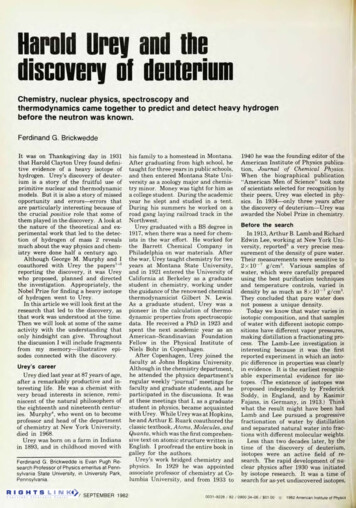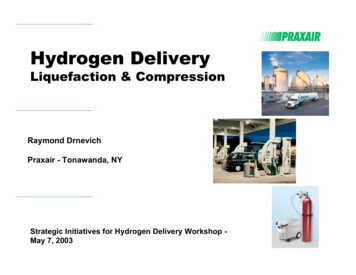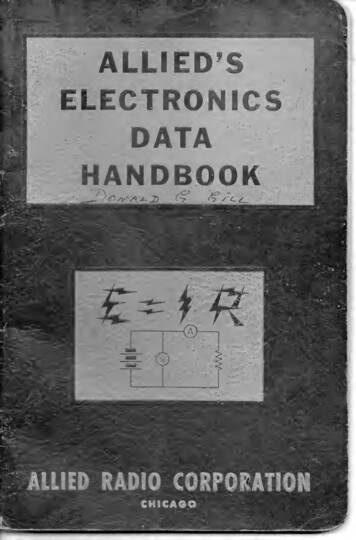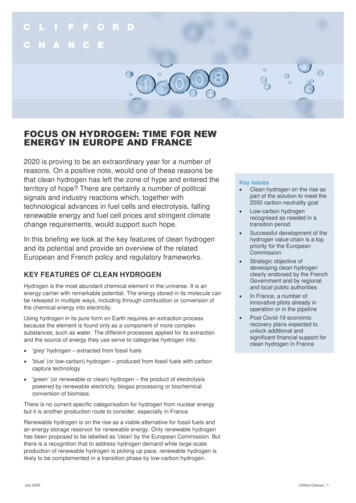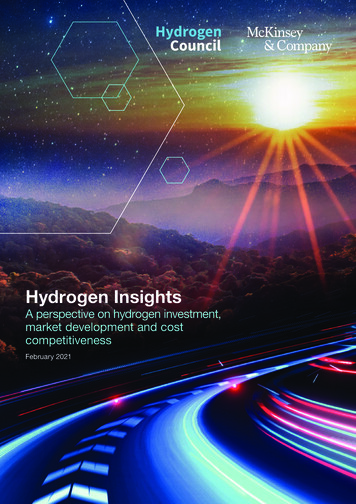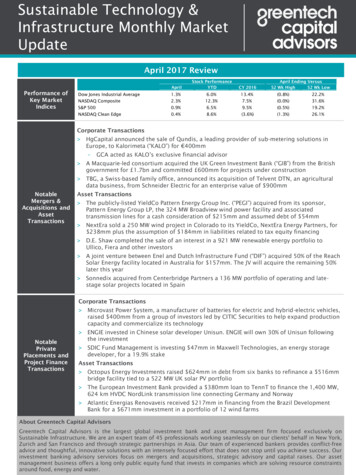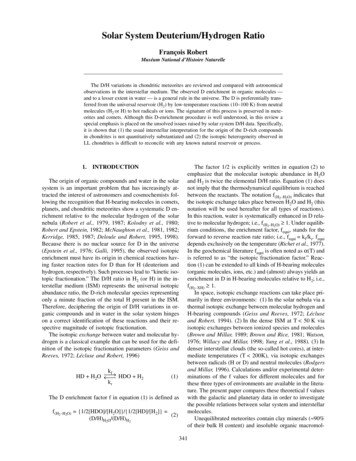
Transcription
Robert: Solar System Deuterium/Hydrogen Ratio341Solar System Deuterium/Hydrogen RatioFrançois RobertMuséum National d’Histoire NaturelleThe D/H variations in chondritic meteorites are reviewed and compared with astronomicalobservations in the interstellar medium. The observed D enrichment in organic molecules —and to a lesser extent in water — is a general rule in the universe. The D is preferentially transferred from the universal reservoir (H2) by low-temperature reactions (10–100 K) from neutralmolecules (H2 or H) to hot radicals or ions. The signature of this process is preserved in meteorites and comets. Although this D-enrichment procedure is well understood, in this review aspecial emphasis is placed on the unsolved issues raised by solar system D/H data. Specifically,it is shown that (1) the usual interstellar interpretation for the origin of the D-rich compoundsin chondrites is not quantitatively substantiated and (2) the isotopic heterogeneity observed inLL chondrites is difficult to reconcile with any known natural reservoir or process.1.INTRODUCTIONThe origin of organic compounds and water in the solarsystem is an important problem that has increasingly attracted the interest of astronomers and cosmochemists following the recognition that H-bearing molecules in comets,planets, and chondritic meteorites show a systematic D enrichment relative to the molecular hydrogen of the solarnebula (Robert et al., 1979, 1987; Kolodny et al., 1980;Robert and Epstein, 1982; McNaughton et al., 1981, 1982;Kerridge, 1985, 1987; Deloule and Robert, 1995, 1998).Because there is no nuclear source for D in the universe(Epstein et al., 1976; Galli, 1995), the observed isotopicenrichment must have its origin in chemical reactions having faster reaction rates for D than for H (deuterium andhydrogen, respectively). Such processes lead to “kinetic isotopic fractionation.” The D/H ratio in H2 (or H) in the interstellar medium (ISM) represents the universal isotopicabundance ratio, the D-rich molecular species representingonly a minute fraction of the total H present in the ISM.Therefore, deciphering the origin of D/H variations in organic compounds and in water in the solar system hingeson a correct identification of these reactions and their respective magnitude of isotopic fractionation.The isotopic exchange between water and molecular hydrogen is a classical example that can be used for the definition of the isotopic fractionation parameters (Geiss andReeves, 1972; Lécluse and Robert, 1996)HD H2OkfkrHDO H2(1)The D enrichment factor f in equation (1) is defined asf(H2–H2O) {1/2[HDO]/[H2O]}/{1/2[HD]/[H2]} (2)(D/H)H2O/(D/H)H2The factor 1/2 is explicitly written in equation (2) toemphasize that the molecular isotopic abundance in H2Oand H2 is twice the elemental D/H ratio. Equation (1) doesnot imply that the thermodynamical equilibrium is reachedbetween the reactants. The notation f(H2–H2O) indicates thatthe isotopic exchange takes place between H2O and H2 (thisnotation will be used hereafter for all types of reactions).In this reaction, water is systematically enhanced in D relative to molecular hydrogen; i.e., f(H2–H2O) 1. Under equilibrium conditions, the enrichment factor, fequi, stands for theforward to reverse reaction rate ratio; i.e., fequi kf /kr. fequidepends exclusively on the temperature (Richet et al., 1977).In the geochemical literature fequi is often noted as α(T) andis referred to as “the isotopic fractionation factor.” Reaction (1) can be extended to all kinds of H-bearing molecules(organic molecules, ions, etc.) and (almost) always yields anenrichment in D in H-bearing molecules relative to H2; i.e.,f(H2–XH) 1.In space, isotopic exchange reactions can take place primarily in three environments: (1) In the solar nebula via athermal isotopic exchange between molecular hydrogen andH-bearing compounds (Geiss and Reeves, 1972; Lécluseand Robert, 1994). (2) In the dense ISM at T 50 K viaisotopic exchanges between ionized species and molecules(Brown and Millar, 1989; Brown and Rice, 1981; Watson,1976; Willacy and Millar, 1998; Yung et al., 1988). (3) Indenser interstellar clouds (the so-called hot cores), at intermediate temperatures (T 200K), via isotopic exchangesbetween radicals (H or D) and neutral molecules (Rodgersand Millar, 1996). Calculations and/or experimental determinations of the f values for different molecules and forthese three types of environments are available in the literature. The present paper compares these theoretical f valueswith the galactic and planetary data in order to investigatethe possible relations between solar system and interstellarmolecules.Unequilibrated meteorites contain clay minerals ( 90%of their bulk H content) and insoluble organic macromol-341
342Meteorites and the Early Solar System IITABLE 1.D/H ( 106)SpeciesGalactic[6]20–50H16 1H110 ( 150/–65)H2OH2O900–43[8]OM[1]1 ( 3/–0.2) 1032 ( 0.7/–1.8) 104 OM[1]Proto-Sun25 5Selected D/H ratios in the galaxy and solar system.LocationfReferencesBig Bang (theoretical)Local interstellar mediumHot coresISM (20–80 K, respectively)Interstellar clouds (hot cores)Cold interstellar cloudsSchramm (1998)Linsky (1993)Gensheimer et al. (1996)Brown and Millar (1989)Personal compilation[3]Personal compilation[3]736–1.763( 20 K) 1250H2Protosolar nebula 4.5 109 yr ago 1Geiss and Gloecker (1998)H2H2H2H2H2Jupiter (spectroscopic)Jupiter (MS in situ)Saturn (spectroscopic)Neptune (spectroscopic)Uranus (spectroscopic) 1 1 12.62.2Mahaffy et al. (1998)Griffin et al. (1996)Feuchtgruber et al. (1998)Feuchtgruber et al. (1998)H2OH2OH2OOM[1]Comet P/HalleyComet HyakutakeComet Hale-BoppHCN in Comet Hale-Bopp12.411.613.292Eberhardt et al. (1995)Bockelée-Morvan et al. (1998)Meier et al. (1998a)Meier et al. (1998b)Planets[7]Gaseous21 826 715–3565 ( 2.5/–1.5)55 ( 35/–15)Comets[7]310 30290 100330 802300 400Interplanetary Particles[7] (IDPs and Antarctic Micrometeorites)90–4000Bulk1500–4000IOM(four determinations)150–300H2OTelluric Planets[7]149 316 000 200780 80100–780H2OH2OH2O–OHLL3.0 and LL3.1 Meteorites[7]730 120–OH88 11800–1100–OHIOM[1]Carbonaceous Meteorites[7]140 10–OH380–620IOM[1]370 6IOM[1]170 �1606 to 12Bulk EarthVenus (atmosphere in situ)Mars (atmosphere in situ)SNC (Mars mantle?)6640314–31in clays and in chondrules(MgSiO3)in chondrules (glass)IOM29Mean statistical value[2](CM,CV,CR)[4](Orgueil CI)[5](Orgueil CI)[5]Amino-acids from CMHydrocarbons, carboxylicacids from CMPersonal compilation[3]Messenger (2000)Aléon et al. (2001)Lecuyer et al. (1998)Donahue et al. (1982)Owen et al. (1988)Leshin et al. (1994); Gillet et al. (2002)Deloule and Robert (1995)3.532–44Deloule et al. (1998)Personal .5Personal compilation[3]Personal compilation[3]Halbout et al. (1990)Personal compilation[3]Pizzarello et al. (1991)Epstein et al. (1987)The f value is defined as (D/H)sample/(D/H)reference. The “reference” D/H ratio (f 1) stands for the molecular hydrogen reservoir fromwhich the H-bearing compounds are formed (see notes [6] and [7]).Notes: [1] IOM insoluble organic matter; SOM soluble organic matter; [2] Statistical distribution: 130 D/H 170 (66%); [3] F.Robert, personal compilation of published data; [4] CM, CV, CR: chondrite types; [5] reference meteorite sample for the protosolarchemical composition; [6] (D/H)reference 16 10 –6; [7] (D/H)reference 25 10 –6; [8] theoretical values.ecules (hereafter referred to as IOM; 10% of H) with IOMsystematically enriched in D by a factor of 2 to 3 relative tothe minerals. The soluble organic molecules are present atthe 100-ppm level and their isotopic compositions are presented in another chapter of this book. Because only a fewknown natural processes are able to cause such large isoto-pic heterogeneity, a knowledge of the internal distributionof the D/H ratio in chondrites might become an efficienttool in reconstructing the conditions of synthesis of waterand organic molecules. However, little progress has beenmade in this direction because of the complexity of the organic materials and because of a lack of experimental ef-
Robert: Solar System Deuterium/Hydrogen Ratioforts to determine precisely the distribution of the D/H ratio at a molecular or mineralogical level.2.NATURAL VARIATIONS OF THEDEUTERIUM/HYDROGEN RATIOIn this section, the natural variations of the D/H ratio instars, ISM, planets, meteorites, and comets are reviewed.Selected data are reported in Table 1.2.1.The Universal Deuterium/Hydrogen RatioDeuterium formed during the “Big Bang” and has subsequently been destroyed in stars. The formation of D insupernova shocks, if possible, does not seem relevant in thegalactic context (Epstein et al., 1976). Therefore the D/Hratio of the ISM should have decreased with time as D-freeH has been injected into space by supernovae or stellarwinds (Galli et al., 1995). However, exact estimates of theoverall decrease in D abundance in the galaxies with timeremain controversial. Measurements with the Hubble SpaceTelescope have given an accurate determination of the local ISM: Linsky et al. (1993) reports D/H ratios of 16.5 1.8 10 –6 and 14.0 1 10 –6 within 1 kpc of the Sun andMcCullough (1991) reported 14 ratios averaging at 15 10 –6.The remarkable agreement between these two sets of datasuggests that there is a single D/H ratio for the average ISM343(cf. review by Linsky, 2003). Note, however, that Gry et al.(1983) or Vidal-Madjar et al. (1983) have argued that theD/H ratio may vary according to the line of sight and thatthe concept of a single ratio for the ISM might be meaningless. In this text, (D/H)H2 16 1 10 –6 is used as a reference ratio to calculate the different f values for the presentday interstellar molecules (see equation (2) and Table 1).The standard Big Bang model of nucleosynthesis predicts a universal abundance of D that, in practice, dependson the baryon-to-photon ratio (Schramm, 1998). The initial D/H ratio of the universe could be around 50 10–6(Geiss and Gloeckler, 1998) (see Table 1).2.2. The Present-Day InterstellarDeuterium/Hydrogen RatioA large enrichment in D is observed in dense molecularclouds in all detectable C-bearing molecules (so-called organic molecules). In these clouds T 10 K and H 103 cm–3.No reliable data exist on H2O because the low density ofHDO in the gas phase prevents its detection. L. D’Hendecourt and F. Robert (unpublished results) estimated fromlaboratory spectra of deuterated ice the detection limit ofHDO in the infrared spectra of the ISM recorded by theInfrared Space Observatory (ISO). According to this laboratory calibration, the D/H ratio of interstellar water vaporshould be 9 10–4. A compilation of the isotopic composition of various interstellar organic molecules is reportedin Fig. 1 in the form of histograms; weighted means arereported in Table 1. The measured large D enhancement (f 1000) does not seem explainable by grain-surface chemistry or by gas-phase reactions involving neutrals, but mightresult from ion-molecule reactions (Watson, 1976; Guélinet al., 1982; Brown and Millar, 1989; Duley and Williams,1984; cf. review by Millar, 2003). Ions are formed in the gasby UV irradiation from nearby stars;UV photons can penetrate deep inside molecular clouds. At a first approximation, the enrichment in D reflects the H2D /H 3 and CH2D /CH 3 ratios that result fromH 3 HD H2D H2(3)CH 3 HD CH2D H2(4)For these two reactions, fequi (H 3 –H2) exp(227/T) andfequi (CH 3–H2) exp(370/T), respectively (Dishoeck, 1999).In the form of H2D and CH2D , D is transferred to the organic molecules via reactions such asFig. 1. Distributions of the D/H ratio in organic species for threedifferent environments: ISM (cold molecular clouds), hot cores,and solar system (protosolar nebula). The origin of the differencein the D/H ratios between ISM and solar system organic moleculesis still an open issue (see discussion in text).H2D CO DCO H2(5)CH2D N DCNH H2(6)leading, in these examples, to f(HCO –H2) and f(HCN–H2) 1000for T 50 K (Guélin et al., 1982; Duley and Williams,1984).The steady state is reached in 106 1 yr, consistent with theestimated lifetime of the cold molecular clouds. Brown andMillar (1989) and Millar et al. (1989) have shown that, be-
344Meteorites and the Early Solar System IIsides reactions (3) and (4), many other reactions are involved in the transfer of D from HD to ions (for example,C2H 2 HD). They have calculated that the measured distribution of D/H ratios in most observed organic moleculescorresponds to reaction durations close to 3 105 yr. In recent and more detailed models, numerous additional reactions are considered (Willacy and Millar, 1998), but theseefforts have not changed the main findings described above:Deuterium chemistry in cold interstellar clouds seems wellunderstood.Determinations of the D/H ratios in organic moleculesand in water have been reported in molecular “hot cores.”Hot cores are warm ( 100 K) and dense (H 107 cm3) andresult — as in the case of Orion-KL — from the formationof young massive stars that heat the surrounding ISM. Spatial resolution of the D/H ratio in HCN molecules revealsthe occurrence of a transition between the cold molecularcloud and the hot core region (Hatchell et al., 1998; Schilkeet al., 1992): the HCN D/H ratio is systematically lower inhot cores than their cold interstellar counterpart (see Fig. 1).It has been proposed that, in hot cores, water results fromthe evaporation of icy mantles that were condensed at muchlower temperature ( 10 K) in the surrounding ISM (Rodgersand Millar, 1996). In hot cores the composition of the gasis mainly neutral (Schilke et al., 1992) and the D exchangeproceeds via reactions such asH DCN HNC D(7)During this reaction f(HCN–H) decreases with time becauseD-rich HCN molecules reequilibrate with H at 150 K andbecomes isotopically lighter than the surrounding cold ISM( 10 K). A similar situation seems to exist for H2O: Measured D/H ratios in H2O in hot cores are systematically lowerthan those calculated for H2O in cold molecular clouds.Therefore it has been proposed that, after its evaporationfrom the grains, water exchanges its D with atomic H, producing a decrease in the D/H ratio as the temperature increases.2.3.The Early Sun and the Giant Gaseous PlanetsThe D/H ratio in the solar nebula (25 5 10 –6) is derived from from two independent lines of evidence: (1) thejovian and saturnian D/H ratios and (2) the present-day solar3He/4He and 4He/H ratios.1. Numerous spectroscopic determinations of the D/Hratio in the upper atmospheres of the giant planets have beenattempted (Beer and Taylor, 1973, 1978; Bezard et al., 1986;de Bergh et al., 1986, 1990; Feuchtgruber et al., 1997, 1998;Griffin et al., 1996; Lellouch et al., 1996; Mahaffy et al.,1998; Niemann et al., 1996; Smith et al., 1989a,b; cf. review by Owen and Encrenaz, 2003). According to Gautierand Owen (1983) the D/H ratio of the two planets shouldreflect the value of the solar nebula. In these planets, D isessentially in the form of HD whose abundance has beenmeasured by the Infrared Space Observatory. These obser-vations are in good agreement with the HD/H2 ratio measured in situ by the Galileo probe mass spectrometer (D/H 26 7 10 –6; see Table 1) (Niemann et al., 1996).2. The D in the early Sun has been converted in 3Heby the thermonuclear reaction D H 3He. Therefore theD/H ratio of the early Sun can be derived from the presentday 3He/4He measured in the solar wind (3He/4Hesolar 3.8 0.5 10–4) (Geiss and Gloecker, 1998), provided the initial3He/4He ratio, 3He/ 4He , of the Sun is knownsn(D/H)early Sun (3He/4Hesolar– 3He/4Hesn) (4He/H)sn(8)The (3He/4He)sn estimated from chondrites or from Jupiter data is the most inaccurate parameter in equation (8).Using the recent jovian estimates, a (3He/4He)sn 1.5 10–4(Mahaffy et al., 1998) corresponds to a (D/H)early Sun 21 5 10–6 (Geiss and Gloecker, 1998) [with (4He/H)sn 10–1].Combining the two determinations we adopt the usualcanonical value for the solar nebula D/H ratio (25 10–6).This ratio is therefore used here to calculate the f valuesreported in Table 1 for all solar system data; i.e., (D/H)H2 25 10–6 in equation (2).As noted previously, there is a slight difference betweenthis solar ratio and the present-day interstellar ratio (D/H 16 10 –6). This difference is caused by the destruction ofISM D in stars since the solar system formed, 4.5 G.y. ago.The latter ratio is consistent with the galactic rate of destruction with time of D in stars (Geiss and Gloecker, 1998).Therefore for an identical D/H ratio in the ISM and in the solar system, the calculated enrichment factors f are different.2.4.The Water-rich Giant PlanetsUranus and Neptune have large icy cores. They exhibitD/H ratios significantly higher than in Jupiter and Saturn(Feuchtgruber et al., 1997). An interpretation of this enrichment is based on formation models of these two planetswhere the cores of the planets grew up by accretion of icyplanetesimals with high (D/H) ratio. Assuming that in theinterior, water from the planetesimals and molecular hydrogen from the gaseous envelope was isotopically equilibratedat high temperature [fequi (H2–H2O) 1] at least once duringthe lifetime of the planet, the initial (D/H) ratio of the watermust have been somewhat higher than the present-day (D/H) ratio in the H2,but lower than the cometary (D/H) ratio.In this model, comets stand as examples of the icy planetesimals at the origin of these two planets. However, the isotopic equilibrium assumption may not apply if the planetsare not fully convective.2.5.The Terrestrial PlanetsIn the case of Mars and Venus, the photodissociation ofwater in their upper atmospheres produces H and D that issubsequently lost to space. Since H is lost faster than D,the two atmospheres have been enriched in D over the last
Robert: Solar System Deuterium/Hydrogen Ratio4.5 G.y. by a Rayleigh distillation process (Donahue et al.,1982; Owen et al., 1988). However, the theory is too imprecise to accurately derive the primordial D/H ratio of theseplanets. In SNC meteorites, hydroxylated minerals exhibitD/H ratios similar to the martian atmospheric value (Leshinet al., 1994, 1996). However, Gillet et al. (2002) haveshown that other mafic minerals in SNCs have D/H ratioseven lower than the terrestrial mantle. Thus the exact valueof the pristine martian D/H ratio is still considered to be anopen question.The D/H ratio on Earth has been recently estimated accurately [D/H 149 3 10–6 (Lécuyer et al., 1998)]. Escapefrom the top of the atmosphere should not have decreasedthe D/H ratio of the oceans significantly ( 1%) since theend of the planetary accretion. This has been shown theoretically [by modeling the flux of H escaping to space (Huntenand McElroy, 1974)] and observationally [on Earth, kerogenand mineral D/H ratios are invariable within 1% throughgeological times (e.g., Robert, 1989)].2.6. Meteorites and Some Remarks onInterplanetary Dust Particles2.6.1. Variations at the whole-rock scale. Little attention has been paid to the origin of variations in the wholerock H-isotopic composition of carbonaceous chondrites[see the review of the available literature data by Robert(2003)]. These meteorites share several common isotopiccharacteristics: (1) At a bulk scale they are all enriched inD with f values between 5 and 12. (2) They contain IOMsystematically enriched in D by a factor 2 to 3 relative to theminerals (Robert and Epstein, 1982; Kerridge et al., 1987;Epstein et al., 1987; Robert et al., 1987; Pizzarello et al.,1991).In Fig. 2, the D/H ratio of the carbonaceous chondritesis reported as a histogram. In meteorites H is present ashydroxyls in phyllosilicates (and to a lesser extend boundto C in organic molecules) but it is collected in the form ofwater in most experiments when the sample is outgassed bystep-heating. All data in Fig. 2 were obtained by outgassingbulk samples under vacuum or in presence of He or molecular oxygen and by analyzing the mass spectrum of thecollected molecular hydrogen after the reduction of water.What fraction of water extracted from an extraterrestrialsample is terrestrial contamination? Surprisingly, detailedexperimental studies indicate that this fraction is small, i.e.,that the relative contribution of the terrestrial contaminationis 15% (Robert and Deloule, 2002). These studies havebeen performed by comparing the D/H ratio of a samplein contact with liquid D-rich water to the same sample incontact with liquid water having a terrestrial D/H ratio. Forexample, after outgassing the Orgueil meteorite ( 10 wt%H2O) overnight at 50 C under vacuum, water extractedabove 50 C shows almost no (additional?) contamination[ 0.04 wt% H2O (Engrand et al., 1999)]. Similarly, alteredolivine in the Semarkona meteorite shows a relative contamination fraction 15%, although the water concentration345Fig. 2. Distribution of the D/H ratio in whole rock carbonaceousmeteorites (N 106). The large range in D/H likely results fromvariations in the alteration water D/H ratio. This water may haverecorded different degree of isotope exchange during parent bodyhydrothermalism, with D-rich organic compounds. The tail towardhigh D/H ratios is likely related to a heliocentric distribution, withthe highest D/H ratios located in the coldest and remote regionsof the solar system (see IDPs in Fig. 3).in this mineral does not exceed 0.2 wt% H2O (Robert andDeloule, 2002). These studies have addressed the specificproblem of the terrestrial contamination by isotopic exchange. However, it should be kept in mind that alterationon Earth of meteoritic minerals — by contact with liquidwater — yields the addition of terrestrial H in the form ofhydroxyl groups. This addition is irreversible at room temperature and the resulting –OH cannot be separated fromthe indigenous –OH by a simple stepwise heating pyrolysis.Most samples reported in Fig. 2 are “falls” and thus havenever been in contact with liquid water on Earth. Therefore the range in D/H ratio reported in Fig. 2 cannot resultfrom different degrees of terrestrial contamination.In several CI and CM meteorites (Cold-Bokkeveld, Murray, Murchison, Orgueil) the IOM has been chemically extracted and purified and its D/H ratio has been determinedby stepwise temperature pyrolysis (Robert and Epstein,1982; Kerridge, 1987; Yang and Epstein, 1983). Althoughthere are large uncertainties about these determinationsbecause of the contamination linked to the acid-extractionprocedures, the IOM D/H ratios lie between 310 and 370 10–6 for these meteorites. Halbout et al. (1990) have arguedthat all these extracts have a similar indigeneous D/H ratioof 370 10 –6, with lower values due to acid contamination.In the case of the Renazzo meteorite, the IOM D/H ratio ismarkedly different from CI-CM with a ratio of 550 10–6.As observed in Fig. 2 the Renazzo-type meteorites (reportedas CR meteorites) are systematically enriched in D relativeto CI-CM. Mass-balance calculation using the C concentration in the bulk samples and the C/H ratio in the OM indicates that the clay minerals have a D/H ratio close to 300
346Meteorites and the Early Solar System II10–6 in Renazzo. Thus, the difference between CI-CM andCR cannot be attributed to the presence of D-rich IOM butmust be due to an enhancement in D abundance at the scaleof the bulk sample. The most puzzling aspect of the variations reported in Fig. 2 is that they greatly exceed the variations observed on Earth for clay minerals formed at temperatures between 0 and 100 C.An isotopic fractionation could occur during liquid watercirculation in a warm parent body (Bunch and Chang, 1980;Sears et al., 1995). As a general rule, clay minerals are depleted in D relative to water from which they formed. As arule of thumb, for temperatures 100 C one can add 10 10–6 to the measured D/H ratio of the minerals in order toobtain the D/H ratio of the water in isotopic equilibriumwith that mineral. This correction is small compared to thetotal variations reported in Fig. 2. Therefore these variationscannot be attributed to different degrees of isotopic exchangewith a water reservoir having a unique D/H ratio.Part of the observed variations in bulk samples may becaused by different mixing ratios between clays and OM.The maximum value for the relative contribution of the organic hydrogen is 10% (i.e., 90% of H is hosted by clays),corresponding to a shift in the D/H ratio of 20 10 –6, i.e.,1 order of magnitude smaller than the total D/H distributionreported in Fig. 2. Several authors have attempted to relatethe C/H ratio to the D/H ratio of the carbonaceous chondrites in order to trace the relative contribution of the organicmatter to the bulk D/H ratio. Although positive correlationshave been found between these two ratios (Kerridge, 1985),these correlations have been met with several counter examples. Thus, the variations in Fig. 2 cannot simply be causedby the differences in the mixing ratio between water andorganic matter.Two small peaks are present in the tail of the distributionin Fig. 2, at D/H equal to 190 and 220 10 –6. In the distribution reported here, all analyses have been used and thusthe same meteorite can be counted more than once. However, reporting an average value for each meteorite — i.e.,having a unique D/H ratio per meteorite — does not alterthe peaks at D/H equal to 190 and 220 10–6. This observation reinforces the statistical value of the distribution. As afirm conclusion of this discussion, the asymmetry of thedistribution reported in Fig. 2 results from a wide range ofD/H ratios both in IOM and in clays. Eiler and Kitchen(2004) have shown that the least-altered CM samples (e.g.,Murchison) have D/H ratios in their matrix and whole rockclose to 150 10–6. Conversely, both whole-rock and matrix samples of altered CM chondrites and their chondrules(e.g., Cold Bokkeveld) have D/H close to 125 10–6. Thedegree of alteration in these samples is traced by severalgeochemical criteria that correlate with the D/H ratio. Following this interpretation, the lowest D/H ratio of the distribution reported in Fig. 2 stands for the isotopic composition of water that was circulating in the parent bodies andthat was at the origin of the mineralogical alteration features; i.e., water D/H 120 10–6. In this interpretation,each whole-rock sample is an open system and a large fraction of the alteration water has been lost, perhaps to space.Finally, it should be noted that the observed distributionof the bulk sample D/H ratio (Fig. 2) could be biased bythe dynamics of meteorite delivery to Earth. Fragments ofdisrupted asteroids have a greater chance to intercept theEarth’s orbit if the parent bodies were initially located atdistances 2.5 AU (Vokrouhlický and Farinella, 2000). Atgreater distances from the Sun, the fragments have a highprobability of being expelled in the outer regions of thesolar system. It is thus unlikely that the asymmetry in Fig. 2reflects the relative proportion of parent bodies in the meteorite source [i.e., the asteroid belt (cf. Meibom and Clark,1999)], which instead might simply reflect the probabilitydistribution for collecting samples on Earth as a functionof the distance of their sources. The D/H distribution ofIDPs supports this interpretation (Fig. 3). Although thesources of IDPs extend far beyond the asteroid belt, theirdistribution mimics that of the carbonaceous chondrites.Therefore, parent bodies located in the far regions of thesolar system have higher D/H ratios than those in the innerasteroid belts.2.6.2. Molecular and mineralogical hosts of the deuterium/hydrogen ratio. There are two types of primitive meteorites in which high D/H ratios have been found: LL3 andFig. 3. Distributions of the D/H ratio in (1) whole-rock samplesof carbonaceous chondrites, (2) LL3 chondrites (chondrules andclay minerals in the matrix), (3) IDPs, and (4) water vapor fromhot cores (Jacq et al., 1990; Gensheimer et al., 1996; personalcompilation of published data). The f unit is used to normalizedthe enrichment in D relative to universal H: D/H 25 10–6 and16 10 –6 for meteorites-comets-IDPs and hot cores, respectively.
Robert: Solar System Deuterium/Hydrogen Ratiocarbonaceous chondrites (referred hereafter to as CCs). TheIOM has been extracted chemically from these two typesof rocks and has been found to be systematically enriched inD: f(H2–IOM) 15–25 in CCs (with most values around 15;i.e., D/H 375 to 625 10–6) and f(H2–IOM) up to 44 in LL3(D/H 1100 10 –6). The possible contamination of IOMduring the chemical procedure has been carefully evaluatedand is negligible ( 7%) (Halbout et al., 1990).The usual interpretation of this isotopic enrichment is“interstellar chemistry.” However, as shown in Fig. 1, thereis a marked gap in D/H ratios between interstellar and solar system organic matter. Such a difference is impossible toreconcile with a simple temperature effect; i.e., the higher thetemperature of ion-molecule reactions, the lower the D/Hratio. The corresponding calculated temperature ( 120 K using reaction (4)) is never reached in the ISM (except aroundmassive hot stars). In addition, if such a high calculated temperature corresponded to a protosolar environment, the corresponding gas density would prevent H from being ionized.Therefore the “interstellar interpretation” should be considered more as an analog with the ISM, rather than as a quantitative model supported by facts.Interstellar medium organic molecules are simple. Chondritic IOM is highly polymerized. It does not seem plausible that the polymerization of such simple D-rich molecules would be associated with a decrease in their D/H ratiosbecause
The standard Big Bang model of nucleosynthesis pre-dicts a universal abundance of D that, in practice, depends on the baryon-to-photon ratio (Schramm, 1998). The ini-tial D/H ratio of the universe could be around 50 10-6 (Geiss and Gloeckler, 1998) (see Table 1). 2.2. The Present-Day Interstellar Deuterium/Hydrogen Ratio
